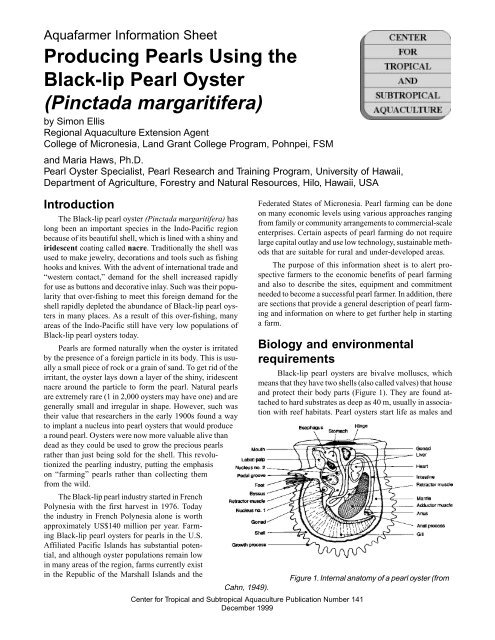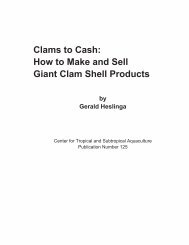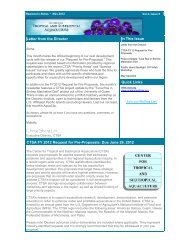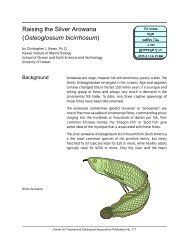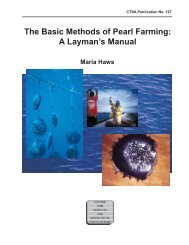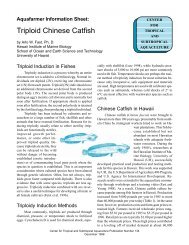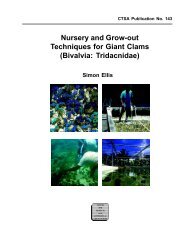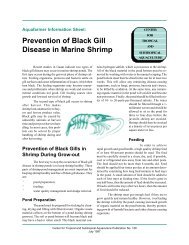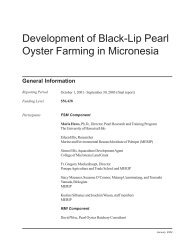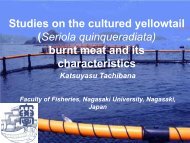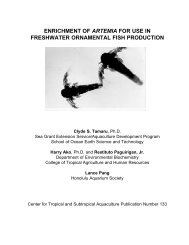Producing Pearls Using the Black-lip Pearl Oyster - CTSA
Producing Pearls Using the Black-lip Pearl Oyster - CTSA
Producing Pearls Using the Black-lip Pearl Oyster - CTSA
You also want an ePaper? Increase the reach of your titles
YUMPU automatically turns print PDFs into web optimized ePapers that Google loves.
<strong>Producing</strong> <strong><strong>Pearl</strong>s</strong> <strong>Using</strong> <strong>the</strong> <strong>Black</strong>-<strong>lip</strong> <strong>Pearl</strong> <strong>Oyster</strong> (Pinctada margaritifera)Page 3in spat settlement. If farmers are aware of <strong>the</strong> time of <strong>the</strong>sepeaks <strong>the</strong>n <strong>the</strong>y can set <strong>the</strong>ir collectors to coincide with maximumspat fall.Hatchery rearing of <strong>Black</strong>-<strong>lip</strong> pearl oysters is a well understoodbut less commonly used method for obtaining animals.At <strong>the</strong> end of 1999 <strong>the</strong>re was only one <strong>Black</strong>-<strong>lip</strong> hatcheryin <strong>the</strong> U.S. Affiliated Pacific Islands in Majuro, RMI.Therefore it is likely that a farmer will need to obtain <strong>the</strong>iroysters using wild or spat collection methods.Farm construction and layoutA pearl farm is simply a structure that allows <strong>the</strong> oystersto be suspended in <strong>the</strong> water column at a depth of 3-7 m.This depth protects <strong>the</strong> oysters from rough wea<strong>the</strong>r whilestill making <strong>the</strong>m accessible to farm workers. Three methodsare primarily used for constructing pearl farms: longlines,rafts and underwater trestles. Farmers should choose <strong>the</strong>method that is cheapest and most convenient for <strong>the</strong> site that<strong>the</strong>y have chosen.Most <strong>Black</strong>-<strong>lip</strong> pearl oysters are farmed on longlines,which are lengths of strong rope anchored to <strong>the</strong> bottom andsuspended with floats at <strong>the</strong> desired depth. The floats alsoprovide tension in <strong>the</strong> line and keep it taught. Longlines arecheap and easy to install and are well-suited to <strong>the</strong> lagoontype farming conditions that prevail throughout <strong>the</strong> U.S. AffiliatedPacific Islands.Rafts (Figure 3) are generally used in well-protectedareas because <strong>the</strong>y float on <strong>the</strong> surface. They are usually constructedfrom barrels or o<strong>the</strong>r large floats and bamboo orwood lashed toge<strong>the</strong>r. Rafts would only be suitable for wellprotectedbays in <strong>the</strong> U.S. Affiliated Pacific Islands.Trestles (Figure 4) have a similar trellis structure to raftsexcept <strong>the</strong>y are attached by legs to <strong>the</strong> ocean floor. Whilesturdy and long-lasting, this system has <strong>the</strong> disadvantage ofbeing more costly than longlines and, like rafts, keeps <strong>the</strong>oysters in high densities <strong>the</strong>reby increasing <strong>the</strong> chances ofdisease outbreak. Trestles are suitable only for shallow bayareas and have been used in French Polynesia for holdingoysters after seeding and as spat nurseries.The choice of how to suspend <strong>the</strong> oysters from <strong>the</strong> farmstructure is also important. Juvenile oysters are usually keptin lantern nets, box nets (Figure 5) or mesh bags until <strong>the</strong>yare around 10 cm in length. At this point <strong>the</strong>y can be transferredinto pocket panels (Figure 5) or onto chaplets (Figure6). A pocket panel is a wire frame with a series of meshpockets into which individual oysters are placed. Chapletsare lengths of rope onto which oysters are hung by a piece ofwire that has been threaded through a hole drilled in <strong>the</strong>shell hinge. Chaplets are cheaper than pocket panels in generalbut oysters are sometimes lost from chaplets because <strong>the</strong>wire holding <strong>the</strong>m to <strong>the</strong> line snaps.Grafting or seedingThe grafting process is one of <strong>the</strong> most expensive andcritical aspects of pearl farming. Grafting (also called seeding)is <strong>the</strong> process whereby a bead or nucleus is implantedinto <strong>the</strong> oyster to form <strong>the</strong> pearl. This is a surgical procedurecarried out by a highly skilled technician who must be paidby <strong>the</strong> farmer. The technician first selects a donor oyster andremoves <strong>the</strong> mantle, which produces <strong>the</strong> nacre for <strong>the</strong> pearl.The mantle is trimmed and cut into small (2 mm) squares.One piece of <strong>the</strong> mantle is inserted into <strong>the</strong> gonad of <strong>the</strong>Figure 3. Raft pearl farm structure (from Gervis and Sims, 1992).Center for Tropical and Subtropical Aquaculture Publication Number 141December 1999
<strong>Producing</strong> <strong><strong>Pearl</strong>s</strong> <strong>Using</strong> <strong>the</strong> <strong>Black</strong>-<strong>lip</strong> <strong>Pearl</strong> <strong>Oyster</strong> (Pinctada margaritifera)Page 4Figure 4. Trestle pearl farm structure (from Gervis and Sims, 1992).pearl oyster, through a small incision made by <strong>the</strong> technician.This is followed by a round nucleus, which is pushedonto <strong>the</strong> mantle tissue so that <strong>the</strong>y touch. If <strong>the</strong> technicianhas done his or her job properly, <strong>the</strong> mantle tissue will growaround <strong>the</strong> nucleus forming <strong>the</strong> pearl sack and laying downan even layer of nacre onto <strong>the</strong> nucleus, which forms <strong>the</strong>pearl. <strong>Pearl</strong> production takes 18-24 months from seeding towhen <strong>the</strong> nacre is 2-3 mm thick. After grafting, approximately10% of <strong>the</strong> oysters will die and a fur<strong>the</strong>r 20% willreject <strong>the</strong> nucleus. Numbers greater than this may indicate apoor technician or onset of disease. <strong>Oyster</strong>s that reject <strong>the</strong>nucleus still have some value. The residual graft and tissueinside <strong>the</strong> oyster forms an irregular pearl known as a keshi.This can be harvested at <strong>the</strong> same time as <strong>the</strong> pearls and soldfor jewelry.Technicians demand a high salary for <strong>the</strong>ir work, but if<strong>the</strong>y are good, <strong>the</strong>ir work will provide high returns for <strong>the</strong>farm. In addition to <strong>the</strong>ir salary, technicians will require roomand board while working on <strong>the</strong> farm and a “seeding platform”on which to work. This is usually a shed built on orclose to <strong>the</strong> farm where oysters are brought for seeding. Itmust be built on a solid foundation and protected from strongbreezes.Although hiring a seeding technician is expensive, <strong>the</strong>cost can often be lowered by offering a portion of <strong>the</strong> harvestprofits as payment ra<strong>the</strong>r than paying all <strong>the</strong> fee up front.This also gives <strong>the</strong> technician a strong incentive to do <strong>the</strong>best job possible of seeding. Technicians will often only travelto an area if <strong>the</strong>y are guaranteed a large amount of work.Small farmers can overcome this problem by forming a cooperativeto hire <strong>the</strong> technician to service all <strong>the</strong> farms.Farm maintenance<strong>Pearl</strong> oysters, especially after seeding, are valuable animalsand <strong>the</strong>refore must be properly maintained. All areasof <strong>the</strong> farm should be visited every 2-3 days to check forbroken or damaged lines. Repairs should take place immediately.Fouling such as algae, sponges and o<strong>the</strong>r bivalvesoccurs rapidly on <strong>the</strong> shell of pearl oysters. This can interferewith feeding and also damage <strong>the</strong> shell if left unchecked.<strong>Oyster</strong>s should be cleaned once every 4-6 weeks. Large farmshave automated cleaning machines but most farms rely ongasoline powered, hand held pressure sprayers to removefouling. In addition <strong>the</strong> lines and floats that hold <strong>the</strong> oystersmust be cleaned on a similar schedule.Small pearl oysters or spat require extra care. They mustbe carefully separated if kept toge<strong>the</strong>r, as <strong>the</strong>y have a tendencyto clump toge<strong>the</strong>r. Their holding containers must beinspected frequently to rid <strong>the</strong>m of predators such as crabsor snails, which can rapidly kill many spat.HarvestHarvesting <strong>the</strong> pearls is as important a process as seedingbecause oysters that produce a high quality pearl can bere-implanted with a new nucleus to produce ano<strong>the</strong>r pearl.A seeding technician (often <strong>the</strong> same one that did <strong>the</strong> initialimplant) makes an incision in <strong>the</strong> pearl sack and removes<strong>the</strong> pearl. The pearl is examined and if it is of a high quality,a new, larger nucleus is inserted into <strong>the</strong> pearl sac and <strong>the</strong>oyster is returned to <strong>the</strong> farm. <strong>Oyster</strong>s can be re-implantedup to 2 times, each time with a nucleus <strong>the</strong> size of <strong>the</strong> harvestedpearl. For example, if an initial nucleus of 5 mm diameterproduces a 7 mm pearl, <strong>the</strong>n a 7 mm nucleus can beCenter for Tropical and Subtropical Aquaculture Publication Number 141December 1999
<strong>Producing</strong> <strong><strong>Pearl</strong>s</strong> <strong>Using</strong> <strong>the</strong> <strong>Black</strong>-<strong>lip</strong> <strong>Pearl</strong> <strong>Oyster</strong> (Pinctada margaritifera)Page 5Figure 5. Containers used to hold pearl oysters (from Gervis and Sims, 1992).re-implanted into <strong>the</strong> oyster. Because large-diameter pearlsfetch a much higher price than smaller ones, <strong>the</strong> larger pearlsproduced by re-implantation eventually contribute greatly to<strong>the</strong> farm’s income.MarketingNot all pearls are created equal. A pearl is graded dependingon its size, color, shape and how it reflects <strong>the</strong> light(luster). It is essential for <strong>the</strong> farmer to have some idea ofpearl grading in order to obtain a fair price for <strong>the</strong> pearls.<strong><strong>Pearl</strong>s</strong> are graded into categories of A, B, C or unsaleable.On <strong>the</strong> average only about 5-10% of <strong>the</strong> harvested pearlswill be classified as grade A. These will provide about 95%of <strong>the</strong> farms income. If <strong>the</strong> technician has done a good job atleast 800 (80%) of every 1,000 pearls harvested will have amarket value. The rest are essentially worthless.The farmer generally sells <strong>the</strong> pearls in lots of 100 ormore to a buyer. Each lot of pearls usually contains pearls ofall grades. The buyer may be a jeweler, <strong>the</strong> grafting technicianor someone who accompanies <strong>the</strong> technician. In someareas such as French Polynesia <strong>the</strong>re are auctions where farmerscan sell <strong>the</strong>ir pearls. An alternative to selling pearls inlots is to market <strong>the</strong>m independently to jewelers or wholesalers.However, this usually requires special knowledge ofpearl grading.Maximizing farm profits does not just mean sellingpearls. Keshi and half-pearls (mabe) can also be sold tosupplement farm income as can <strong>the</strong> meat and <strong>the</strong> shell of <strong>the</strong>oyster. The shell can be made into polished ornaments andjewelry such as fishing lures, earrings, pendants and necklaces.EconomicsIt is very difficult to give an example budget for operatinga pearl farm because each farm has a unique structure,location and size. However, this section will list a number ofparameters that should be budgeted by a prospective farmerto one degree or ano<strong>the</strong>r in <strong>the</strong> construction and running ofa farm. It should again be noted that it takes 2-4 years ofoperation before <strong>the</strong> first pearls can be harvested from afarm. The major expenses of starting and operating a farmare listed on <strong>the</strong> following page.Center for Tropical and Subtropical Aquaculture Publication Number 141December 1999
<strong>Producing</strong> <strong><strong>Pearl</strong>s</strong> <strong>Using</strong> <strong>the</strong> <strong>Black</strong>-<strong>lip</strong> <strong>Pearl</strong> <strong>Oyster</strong> (Pinctada margaritifera)Page 6Figure 6. <strong>Pearl</strong> oysters held on chaplets (photo by MariaHaws).Capital costs• Cost of obtaining pearl oysters ei<strong>the</strong>r by spat collection,hatchery production or wild adult collection• Equipment and supplies• Farm structure (lines, rafts, underwater trestles, floats)• Farm and seeding platform• BoatsOperating costs• Labor• Electricity, water, telephone or radio• Gas and oil for boats or vehicles• Replacement costs for equipment and supplies• Licenses or permits• Fees for grafting technician• Marketing expensesThe following are some of <strong>the</strong> major factors that influencecosts.1. Farm size - In general, 3,000 pearl oysters is <strong>the</strong> minimumnumber needed for a profitable farm because <strong>the</strong>reare certain fixed costs which will be too high if fewerpearl oysters are available for cultivation. The size of<strong>the</strong> farm will also determine <strong>the</strong> quantity of materialssuch as lines and floats needed, and <strong>the</strong> labor costs ofmaintaining <strong>the</strong> farm.2. Labor - <strong>Pearl</strong> farming is labor intensive. A pearl farmwith 3,000 pearl oysters and several spat collector lines,will require a full-time farmer with 1 or 2 part-timeassistants. Since it takes a minimum of 2-3 years toreach <strong>the</strong> first harvest, an alternative source of incomemust be available to support <strong>the</strong> farmer, as well as sufficientfunds to hire some workers during this time.3. Equipment, supplies and facilities - The cost of equipmentwill be determined by <strong>the</strong> size of <strong>the</strong> farm and by<strong>the</strong> type of facilities already available in your location.Often farmers can benefit by sharing certain equipmentor facilities such as SCUBA compressors or graftingplatforms.4. Location - The far<strong>the</strong>r <strong>the</strong> pearl farm is from <strong>the</strong>farmer’s house or boat dock, <strong>the</strong> more it costs to buygas to reach it. Also <strong>the</strong> amount of ropes, floats andanchors will vary according to <strong>the</strong> type of site chosen.5. Spat source - Since spat collection is <strong>the</strong> main sourceof young pearl oysters, <strong>the</strong> number of spat collectorsneeded must be estimated along with <strong>the</strong> cost for collectormaterials, lines and gas to service <strong>the</strong> lines. Ifspat are purchased from a hatchery, this cost must betaken into consideration. Whichever method is usedto obtain spat, <strong>the</strong> cost of raising <strong>the</strong>m to grafting sizemust also be calculated. The smaller <strong>the</strong> spat collectedor purchased, <strong>the</strong> higher <strong>the</strong> cost of caring for <strong>the</strong>muntil <strong>the</strong>y reach grafting size. If adult pearl oysters areused, transportation and diving costs must be considered.6. Grafting - Hiring a grafting technician and paying hisor her expenses is one of <strong>the</strong> major expenses for anyfarm. A technician will usually charge US$3-4 per pearloyster seeded, or will take part of <strong>the</strong> harvest as a share.The expense of his or her transportation, lodging andmeals will depend on where <strong>the</strong> farm is located.7. Marketing expenses - Selling pearls can be a lengthy,complicated process requiring local and foreign travel,communications and presentation costs. Start makingmarketing contacts well before <strong>the</strong> harvest, and budgetfor <strong>the</strong> expenses incurred in finding a buyer who iswilling to pay a good price for your pearls.8. Miscellaneous expenses - It is important to allow forextra funds to pay for things such as repairs, miscellaneousexpenses, communications costs, permit fees,taxes, etc.Center for Tropical and Subtropical Aquaculture Publication Number 141December 1999
<strong>Producing</strong> <strong><strong>Pearl</strong>s</strong> <strong>Using</strong> <strong>the</strong> <strong>Black</strong>-<strong>lip</strong> <strong>Pearl</strong> <strong>Oyster</strong> (Pinctada margaritifera)Page 7Fur<strong>the</strong>r informationThis information sheet is designed to give only basicinformation on pearl farming. Before starting a farm it isimportant to contact <strong>the</strong> local marine resource departmentto seek technical assistance and to ensure that any existinglocal laws on marine leasing and oyster collection are adheredto.<strong>CTSA</strong>, Hawaii Sea Grant and <strong>the</strong> College of MicronesiaLand Grant program operate an aquaculture extension networkdesigned to provide information and assistance in allforms of tropical aquaculture. They can be reached at <strong>the</strong>following addresses:Regional Aquaculture Extension AgentCOM Land GrantP.O. Box 1179Kolonia, Pohnpei, FM 96941Tel. 691-320-2728Fax 691-320-2726e-mail: sellis@mail.fm<strong>CTSA</strong>The Oceanic Institute41-202 Kalanianaole Hwy.Waimanalo, HI 96795, USATel. 808-259-7951Fax 808-259-8395e-mail: chenglee@hawaii.eduUniversity of HawaiiSea Grant Extension Service2525 Correa Road, HIG 237Honolulu, HI 96822, USATel. 808-956-8191Fax 808-956-2858Dr. Maria Haws<strong>Pearl</strong> <strong>Oyster</strong> Specialist<strong>Pearl</strong> Research and Training ProgramUniversity of HawaiiDepartment of Agriculture, Forestry and Natural Resources200 W. Kawili StreetHilo, Hawaii 96720, USATel. 808-933-9707e-mail: Haws@aol.comFur<strong>the</strong>r readingAquilina, B. and W. Reed. 1997. Lure of <strong>the</strong> pearl. KimbooksPty., Australia. 135 pp.Cahn, A.R. 1949. <strong>Pearl</strong> Culture in Japan. Fisheries leaflet.United States Department of <strong>the</strong> Interior, WashingtonDC.Clarke, R., D. Sarver and N.A. Sims. 1996. Some recenthistory and prospects for <strong>the</strong> <strong>Black</strong>-<strong>lip</strong> pearl oyster,Pinctada margartiferai in Hawaii and Micronesia.Twenty-sixth Regional Technical Meeting on Fisheries,Noumea, New Caledonia. 10 pp.Gervis, M.H. and N.A. Sims. 1992. The biology and cultureof pearl oysters (Bivalvia: Pteridae). ICLARM Studiesand Reviews 21. 49 pp.Haws. M. 1999. <strong>Pearl</strong> farming: a manual of basic methods.<strong>CTSA</strong> publication, in print.PeriodicalsOut of <strong>the</strong> Shell. Coastal Resource Research Network Newsletter,Lester Pearson International, Dalhousie University,1321 Edward Street, Halifax, NS Canada B3H 3H5.<strong>Pearl</strong> <strong>Oyster</strong>, Information Section Marine Resource Division,Secretariat of <strong>the</strong> Pacific Community, B.P. D5, 98848Noumea Cedex, New Caledonia.VideosHaws, M.C., A.O. Bailey and M. Ogden. 1997. <strong>Producing</strong><strong>Black</strong> <strong><strong>Pearl</strong>s</strong>. Pacific Aquaculture Development Program,UHM Sea Grant, SOEST, Honolulu, HI.Haws, M.C., M. Ogden and A.O. Bailey. 1999. Grafting<strong>Black</strong> <strong>Pearl</strong> <strong>Oyster</strong>s. Pacific Aquaculture DevelopmentProgram, UHM Sea Grant, SOEST, Honolulu, HI.GlossaryFouling, biofouling: small plants and animals that colonize<strong>the</strong> shell of <strong>the</strong> pearl oyster.Gonad: reproductive organ producing ei<strong>the</strong>r sperm or eggs.Grafting: also known as seeding or nucleus implantation.This is a surgical procedure in which <strong>the</strong> nucleus and asmall piece of mantle tissue are inserted into <strong>the</strong> gonadthus starting development of a cultured pearl.Iridescent: exhibiting a display of colors producing rainboweffects.Keshi: <strong>the</strong> word “keshi” means poppy in Japanese. Keshipearls are a by-product of <strong>the</strong> grafting process that occurwhen <strong>the</strong> implanted piece of mantle tissue secretesnacre around itself producing small, irregularly shapedpearls without a nucleus.Center for Tropical and Subtropical Aquaculture Publication Number 141December 1999
<strong>Producing</strong> <strong><strong>Pearl</strong>s</strong> <strong>Using</strong> <strong>the</strong> <strong>Black</strong>-<strong>lip</strong> <strong>Pearl</strong> <strong>Oyster</strong> (Pinctada margaritifera)Page 8Larval, larvae: an early developmental stage of <strong>the</strong> pearl oysterlife cycle when <strong>the</strong> pearl oyster is a microscopic andfree-swimming organism. This period last 2-3 weeks.Mabe or half pearl: dome-shaped secretions of nacre developedover an artificial form that is attached to <strong>the</strong> shell.Mantle: part of <strong>the</strong> tissue of <strong>the</strong> oyster that lays down <strong>the</strong>nacre.Metamorphosis: developmental stage involving anatomicaland behavioral changes that transform <strong>the</strong> free-swimminglarvae to a settled adult.Nacre or mo<strong>the</strong>r-of-pearl: The iridescent material lining <strong>the</strong>inside of mollusk shells. Nacre is composed of calciumcarbonate crystals (aragonite) deposited between layersof organic material. Nacre is one of <strong>the</strong> types of shellmaterial formed by <strong>the</strong> epi<strong>the</strong>lial cells in <strong>the</strong> mantle tissue.Nucleus: a small, polished bead made from <strong>the</strong> shell of freshwatermussels used as <strong>the</strong> core of cultured pearls.<strong>Pearl</strong> sack: <strong>the</strong> tissue containing <strong>the</strong> nacre-producing epi<strong>the</strong>lialcells which enclosed <strong>the</strong> developing pearl. Thepearl sac develops out of <strong>the</strong> transplanted piece of mantletissue (<strong>the</strong> graft) that is inserted into <strong>the</strong> gonad duringgrafting. This term may also be used to refer to <strong>the</strong> extremeend of <strong>the</strong> gonad where <strong>the</strong> nucleus is inserted.Spat: juvenile pearl oysterSpawn, spawning: release of eggs or sperm by <strong>the</strong> pearl oysterinto <strong>the</strong> water.AcknowledgmentsThis publication was prepared as part of <strong>the</strong> work undera project titled “Aquaculture Extension and Training Supportin <strong>the</strong> U. S. Affiliated Pacific Islands - Year 10.” Fundingwas partially provided by <strong>the</strong> Center for Tropical andSubtropical Aquaculture through a grant from <strong>the</strong> CooperativeState Research Service of <strong>the</strong> U.S. Department of Agriculture(grant #97-38500-4042). This publication is alsofunded in part by a grant from <strong>the</strong> Pacific Aquaculture DevelopmentProgram which is sponsored by <strong>the</strong> U.S. Departmentof <strong>the</strong> Interior, Office of Insular Affairs (grant #GEN103), and in part by a grant/cooperative agreement from <strong>the</strong>National Oceanic and Atmospheric Administration, project#A/AS-1, which is administered by <strong>the</strong> University of HawaiiSea Grant College Program, SOEST, under InstitutionalGrant No. NA86RG0041 from NOAA Office of Sea Grant,Department of Commerce. The views expressed herein arethose of <strong>the</strong> authors and do not necessarily reflect <strong>the</strong> viewsof <strong>the</strong> U.S. Department of Agriculture, U.S. Department of<strong>the</strong> Interior, <strong>the</strong> Center for Tropical and Subtropical Aquaculture,<strong>the</strong> Pacific Aquaculture Development Program or anystaff of those agencies. UNIHI-SEAGRANT-TR-98-07.Center for Tropical and Subtropical Aquaculture Publication Number 141December 1999


